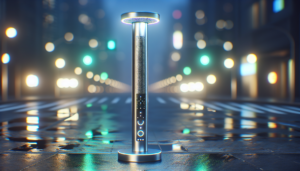Have you ever wondered how technology can change the way we shop? Augmented Reality (AR) is one of those innovations that is revolutionizing retail as we know it. By blending the digital and physical worlds, AR is creating unique shopping experiences that can enhance customer engagement, boost sales, and build brand loyalty. Let’s take a closer look at how AR is transforming the retail landscape.
What is Augmented Reality?
To start, I think it’s important for us to get on the same page about what we mean by augmented reality. AR is a technology that overlays digital information, such as graphics, sounds, or texts, onto the real world. By using devices like smartphones or AR glasses, I can visualize data in context, enriched by immersive visual experiences. This merging of the physical and digital realms can not only make my shopping experience more interactive but also much more enjoyable.
The Importance of AR in Retail
Enhancing the Shopping Experience
One of the primary benefits of AR in retail is how it enhances the shopping experience. I can try on clothes virtually, see how furniture would look in my home, or even experiment with different makeup shades without having to physically move from place to place. This not only saves time but also makes the purchase decision much easier.
Increasing Customer Engagement
With AR, retailers can capture my attention in ways that traditional shopping cannot. I find myself engaging with brands that offer interactive elements—be it through games, trivia, or virtual windows that showcase how a product works in real life. This captivating experience keeps me focused on the brand and encourages me to make purchases.
Reducing Return Rates
Another significant advantage is that AR helps to reduce return rates. When I can accurately visualize a product, whether it’s clothing fitting my personal style or how a piece of furniture will suit my living room, I’m more likely to be happy with my purchase. Studies have shown that retailers leveraging AR see fewer returns compared to those that don’t.
Applications of AR in Retail
There are numerous ways that retailers are implementing AR in their strategies. Here are a few key applications:
Virtual Fitting Rooms
Virtual fitting rooms are changing the way I shop for clothing. Retailers like Zara and ASOS have adopted this technology, allowing me to “try on” clothes using my smartphone camera. This feature not only saves me time but also adds an element of fun to the shopping experience.
Product Visualization
Many furniture and home décor brands like IKEA have embraced AR for product visualization. With their apps, I can place a virtual piece of furniture in my own living room to see if it matches my style and space before I ever make a purchase. This application extends to various types of products—from appliances to artwork—helping me make informed decisions.
Interactive Packaging
Imagine picking up a snack that, when scanned with my phone, gives me access to a world of interactive content, nutrition facts, and even recipes. This is the essence of interactive packaging. Brands are now using AR to turn standard packaging into dynamic experiences that enhance my understanding of the product.
AR Navigation in Stores
When I visit a large department store, I often find it challenging to locate specific items. Some retailers have introduced AR navigation within their store apps to guide me. By scanning the store layout, I can receive turn-by-turn directions to find my desired products easily. It’s a time-saver that keeps me coming back for more!
Challenges in Implementing AR
While I find the potential of AR exciting, retailers face several challenges when trying to implement these technologies effectively. Understanding these hurdles is essential to appreciate the evolution of AR in retail.
High Development Costs
Building AR applications can be a costly endeavor. For many small and medium-sized businesses, the financial investment required to develop high-quality augmented reality experiences is a deterrent. As much as I’d love to see these experiences flourish, costs can be a significant barrier to entry.
Technical Limitations
Sometimes, the existing infrastructure doesn’t support the new technologies as effectively as we would like. Not all smartphones or devices are AR-capable, which can limit who among my peers can access these innovative shopping experiences. Moreover, technical glitches can also lead to user frustration.
User Adoption and Education
Some people are still unfamiliar with AR technology and how to use it. As someone who enjoys trying new things, I realize that many shoppers may be hesitant to adopt AR experiences. Retailers will need to invest time and resources in educating me and others on how to use these technologies effectively.
Future Trends in AR Retail Innovations
Greater Personalization
As the technology evolves, I foresee a future where AR will offer increasingly personalized experiences. Imagine walking into a store and having an AR system recognize me, suggesting items based on my previous purchases or preferences. This tailored approach could vastly enhance my shopping experience.
Integration with AI
The integration of AR with Artificial Intelligence (AI) will allow for advanced predictive behaviors. I could receive customized promotions based on my shopping habits or location. This synergy could lead to an explosive growth in retail innovation, making the shopping experience more fluid and tailored.
Social Shopping Experience
I often shop with friends or seek their opinions when making purchases. Future AR innovations may incorporate social features, allowing me to virtually “shop together” with others, even if they’re miles away. Real-time shared experiences could revolutionize the way I perceive retail.
Brands Leading the Way
It’s inspiring to see how some brands are at the forefront of AR innovation. Here are just a few notable examples that have maximized AR in retail:
IKEA
IKEA’s AR app allows me to place furniture items in my home using my smartphone camera. This visualization can help me understand scale, color, and overall aesthetics before making a choice.
Sephora
Sephora’s Virtual Artist feature enables me to try on makeup virtually. I can experiment with different products and looks, ensuring that I choose what matches my personal style before purchasing.
L’Oreal
L’Oreal offers a similar service called the Makeup Genius app. With this, I can see how various cosmetics will look on my face without the need for testers. This eliminates uncertainty and enhances my shopping experience.
Adidas
Adidas has created an AR app that allows me to customize and visualize my shoes in 3D. This interactive approach not only makes shopping fun but also allows for a level of personalization that many brands lack.
Benefits of AR for Retailers
It’s not just customers like me who benefit; retailers gain numerous advantages from implementing AR as well.
Increased Sales
Businesses implementing AR often see an increase in sales. Interactive elements drive customer engagement and lead to a higher likelihood of making a purchase. My enhanced shopping experience frequently translates into converted sales.
Brand Differentiation
In a competitive market, AR can help a brand stand out. By utilizing advanced technology, retailers create buzz and draw attention to their offerings, making it more likely that I will remember their brand when it comes time to shop again.
Improved Customer Insights
Through interactive AR experiences, retailers can gather valuable insights into customer behavior. By tracking how I use their AR features, they can refine their offerings and marketing strategies, making sure they meet my preferences and needs.
Best Practices for Retailers Using AR
So, what can retailers do to ensure they’re using AR effectively? Here are some best practices to keep in mind:
Prioritize User Experience
I appreciate when a retail brand prioritizes my experience over the technology itself. A seamless, user-friendly AR experience should be the goal, making it simple and enjoyable for me to explore and purchase products.
Implement Clear Instructions
To enhance my understanding of AR features, I appreciate clear instruction on how to use them. This can include videos, tutorials, or even in-store assistance. Educating me on how to engage with the technology will increase my likelihood of using it.
Invest in Quality Development
Quality is key. Retailers need to invest in highly functioning and engaging AR tools. A poorly designed app will not only frustrate me but will also lead to negative perceptions of the brand.
Conclusion
As I think about all that we’ve explored, it’s clear that augmented reality is not just a passing trend in retail; it’s reshaping the entire shopping experience. By facilitating virtual fitting rooms, providing product visualization, and integrating social features, AR is enriching my interactions with brands.
Although challenges exist—such as costs and user education—the benefits far outweigh the drawbacks. For me, AR transforms mundane shopping into an engaging and interactive adventure—one where I can have fun while making informed decisions.
As we move further into the future, I look forward to seeing how AR continues to innovate and evolve in the retail sector. The marriage of technology and shopping promises endless possibilities, and I am excited to see how it will enhance my experiences as a consumer.






